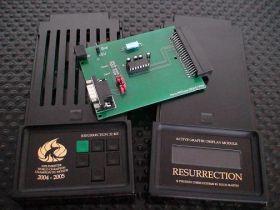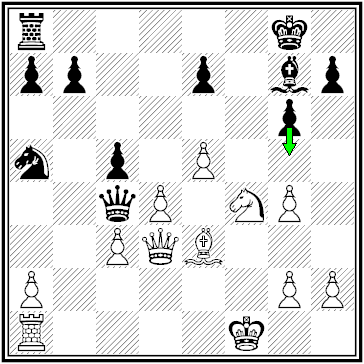Phoenix Chess Systems Resurrection
| Phoenix Chess Systems Resurrection | ||
|---|---|---|
 | ||
| Hersteller | Phoenix Chess Systems | |
| Markteinführung | 2004 | |
| CElo | Engine abhängig (2500 Fruit'05) | |
| Programmierer | Ruud Martin | |
| Prozessor | StrongARM | |
| Prozessortyp | 32 Bit | |
| Takt | 203 MHz | |
| RAM | 12 MB | |
| ROM | Engine abhängig | |
| Bibliothek | Engine abhängig | |
| Einführungspreis | 1250 € | |
| Rechentiefe | Engine abhängig | |
| BT-2450 | - | |
| BT-2630 | 2420 (Ruffian) | |
| Colditz | - | |
| Verwandt | Resurrection II, Revelation | |
| Zugeingabe | Magnetsensoren | |
| Zugausgabe | 64 Feld LEDs | |
| Display | 2 x 16-stellige Punktmatrix Anzeige | |
| Stromversorgung | Netzteil 5V/1A oder 9V/1A (je nach Anschlussart) | |
| Spielstufen | frei programmierbar | |
| Maße | Modulset | |
| Sonstiges | ||
| Eigenentwicklung von Ruud Martin (NED) für das modulare System von Mephisto. | ||
Es können verschiedene Engines eingespielt werden.
Momentan stehen
- Fruit'05 & Fruit 2.1 by Fabien Letouzy
- Ruffian 2.1 by Perola Valfridsson
- Deep Sjeng 1.8 by Gian-Carlo Pascutto
- Toga 1.0 & 1.2 by Thomas Gaksch
- Rybka 2.2 by Vasik Rajlich
zur Verfügung.
Laut Ruud Martin ist es möglich, UCI, Winboard und XBoard-Engines einzuspielen. Das Einspielen ist allerdings nur durch Ruud Martin möglich. Programmupdates (inkl. neue Engines) können vom Benutzer per seriellem Kabel eingespielt werden.
-
Prototyp beim D.A.CH Turnier 2004
-
Neues Resurrection II Display
Der Gewinner des Turniers D.A.CH 2004
Das bis dato am stärksten besetzte Brettschachcomputer Turnier (D.A.CH. 2004) ist zu Ende. Der Sieger wurde mit 8 Runden im Schweizer System bei einer Bedenkzeit von 30"/Zug ermittelt. Wie so häufig sollte erst die letzte Runde die Entscheidung bringen.
Die Mephisto Turnier Maschine London (68030, 36 MHz) hatte bereits gewonnen und sagenhafte 7 aus 8 Punkte erreicht. Ruud Martins Resurrection (6,5 Punkte) mußte somit unbedingt gegen den Risc 2 (4,5) punkten um Gesamtsieger zu werden. Auch die Tasc R30 Version 2.5 (5) benötigte für den dritten Platz einen vollen Punkt gegen den superschnellen Elite V.11 (68060, 72 MHz) mit bisher 4 Punkten.
In der Partie Resurrection gegen Risc 2 waren beide Geräte mit der Eröffnungsbehandlung zufrieden und bewerteten ihre eigene Stellung jeweils positiv. Im weiteren Spielverlauf kann Risc 2, dem rund 15 mal schnellerem Programm mit der Ruffian Engine, positionell gegenhalten und sogar einen Bauern gewinnen. Resurrection forciert danach den Figurentausch und wickelt in ein für ihn verlorenes Endspiel mit zwei Minusbauern ab.
In dieser Stellung nach dem 40. Zug Kf4 gewinnt fast jede schwarze Antwort. Z.B. f6 (verhindert Ke5) oder Kc5 (holt den Bauern b6) oder a5 oder ... Die umstehenden Beobachter wollten Schwarz bereits zum Sieg gratulieren. Doch Risc 2 entscheidet sich mit einer Bewertung von über +7 Bauerneinheiten für Ka3?? Nun wird aus dem bereits sicher geglaubten Sieg noch ein Remis. Der weisse König gelangt über e5 nach c7 und holt sich auch eine Dame. Doch es kommt noch schlimmer! Auf 41. Ke5 folgt - ganz wie bei einem schockierten menschlichen Spieler - mit 41. ..g5 der zweite Fehler sofort hinterher. Nun ist die Partie bereits verloren. Innerhalb von lediglich zwei Zügen wurde aus einer +7 Bewertung -6.
Risc 2 wurde nach der Partie natürlich nochmal überprüft. In der Analysestufe errechnet er reproduzierbar im 10. Hz (nach 19 Sekunden) Ka3 als besten Zug. Er bewertet die Stellung mit knapp 5 Bauern für sich. Im 11. Hz, nach 32(!) Sekunden, geht ihm ein Licht auf (die Bewertung sinkt auf -1.6) und er schwenkt auf Kb5 um.
Das Ganze war für Ed Schröders Weltmeister Programm von 1992 echt dumm gelaufen. Risc 2 traf auf ein für ihn fatales Zeitfenster von 19..32 Sekunden. Im übrigen war es der 40. Zug. Vielleicht gibt es - selbst in der 30"/Zug Stufe - so etwas wie Zeitnot und er gönnte sich nicht ausreichend Bedenkzeit?
Damit wurde Resurrection mit 7,5 Punkten der verdiente Turniersieger von D.A.CH 2004. Aus der Sicht aller Teilnehmer auch völlig zurecht. Resurrection wurde einhellig als das stärkste Gerät im Feld empfunden. Wie andere Schachcomputer auch, hatte er diesmal in der letzten Partie das Glück des Tüchtigen. Gratulation an den sympathischen Ruud Martin!
Turniertabelle und Partien
| P | Chess Computer | Score | (Tie) | 1 | 2 | 3 | 4 | 5 | 6 | 7 | 8 | + / - / = |
|---|---|---|---|---|---|---|---|---|---|---|---|---|
| 1: | Resurrection Ruffian / Ruud Martin | 7.5 / 8 | 37.0 | 11b+ | 8w+ | 2b+ | 3w= | 10b+ | 7w+ | 6b+ | 4w+ | (+7 -0 =1) |
| 2: | TM Mephisto London 68030 / Hans van Mierlo | 7.0 / 8 | 35.0 | 9b+ | 16w+ | 1w- | 7b+ | 3b+ | 8w+ | 10b+ | 11w+ | (+7 -1 =0) |
| 3: | Tasc R30 V2.5 / Bernhard Grimm | 6.0 / 8 | 39.5 | 6w= | 4b+ | 12w+ | 1b= | 2w- | 5b+ | 7b+ | 8w+ | (+5 -1 =2) |
| 4: | Mephisto Risc II / Bernhard Drexler | 4.5 / 8 | 34.0 | 17b+ | 3w- | 8b- | 5w+ | 15b+ | 10w= | 14w+ | 1b- | (+4 -3 =1) |
| 5: | Mephisto Genius 68030 / Josef Zwinger | 4.5 / 8 | 31.5 | 12w= | 7b- | 13w+ | 4b- | 9w+ | 3w- | 16b+ | 10w+ | (+4 -3 =1) |
| 6: | Saitek Risc 2500 / Frank Jäger | 4.5 / 8 | 31.0 | 3b= | 18w+ | 10b- | 16w+ | 7w- | 11b+ | 1w- | 14b+ | (+4 -3 =1) |
| 7: | Saitek Sparc / Gerhard Vetter | 4.0 / 8 | 37.5 | 18b= | 5w+ | 15b+ | 2w- | 6b+ | 1b- | 3w- | 9w= | (+3 -3 =2) |
| 8: | Fidelity Elite Version 11 / Robert Weck | 4.0 / 8 | 37.5 | 14w+ | 1b- | 4w+ | 10w- | 16b+ | 2b- | 13w+ | 3b- | (+4 -4 =0) |
| 9: | Fidelity Elite V10 / Steffen Scholz | 4.0 / 8 | 29.0 | 2w- | 14b- | 18b+ | 11w= | 5b- | 17w+ | 12w+ | 7b= | (+3 -3 =2) |
| 10: | Tasc R30 V2.2 / Alwin Gruber | 3.5 / 8 | 37.0 | 16b- | 17w+ | 6w+ | 8b+ | 1w- | 4b= | 2w- | 5b- | (+3 -4 =1) |
| 11: | Mephisto Magellan / Hein Veldhuis | 3.5 / 8 | 33.0 | 1w- | 15b- | 17w+ | 9b= | 12w+ | 6w- | 18b+ | 2b- | (+3 -4 =1) |
| 12: | Novag Star Diamond / Helmut Hoffmann | 3.5 / 8 | 28.0 | 5b= | 13w+ | 3b- | 15w= | 11b- | 18w= | 9b- | 16w+ | (+2 -3 =3) |
| 13: | Mephisto Berlin Pro / Hsu Mo Sai | 3.5 / 8 | 24.0 | 15w= | 12b- | 5b- | 14w= | 18b+ | 16w= | 8b- | 17w+ | (+2 -3 =3) |
| 14: | Novag Sapphire II / Cathi Reszka | 3.0 / 8 | 28.5 | 8b- | 9w+ | 16b- | 13b= | 17w= | 15w+ | 4b- | 6w- | (+2 -4 =2) |
| 15: | Mephisto Polgar / Alexander Riedl | 3.0 / 8 | 25.5 | 13b= | 11w+ | 7w- | 12b= | 4w- | 14b- | 17b- | 18w+ | (+2 -4 =2) |
| 16: | Mephisto Berlin 68000 / Franz Wagner | 2.5 / 8 | 33.5 | 10w+ | 2b- | 14w+ | 6b- | 8w- | 13b= | 5w- | 12b- | (+2 -5 =1) |
| 17: | Mephisto Roma 32 / Wolfgang Spiekermann | 2.5 / 8 | 26.0 | 4w- | 10b- | 11b- | 18w+ | 14b= | 9b- | 15w+ | 13b- | (+2 -5 =1) |
| 18: | Dominator 2.04 / Gernot Holm | 1.0 / 8 | 28.5 | 7w= | 6b- | 9w- | 17b- | 13w- | 12b= | 11w- | 15b- | (+0 -6 =2) |
- 72 games: +36 -23 =13
Geschwindigkeitsvergleich
Stellung BT2630 #24
R7/3p3p/8/3P2P1/3k4/1p5p/1P1NKP1P/7q w - - 0 1
Fruit 2.1, Pentium M, 1.6 GHz, 16 MB Hash: 1.g6 in 2 sec, depth = 10 Fruit 2.1, XScale 400 MHz, 16 MB Hash: 1.g6 in 44 sec, depth = 10 Fruit 2.1, XScale 200 MHz, 16 MB Hash: 1.g6 in 97 sec, depth = 10 Fruit 2.1, XScale 100 MHz, 16 MB Hash: 1.g6 in 185 sec, depth = 10 Fruit 2.1, Resurrection V2.06, 12 MB Hash: 1.g6 in 228 sec, depth = 8
Stellung BT2630 #9
r5k1/pp2p1bp/6p1/n1p1P3/2qP1NP1/2PQB3/P5PP/R4K2 b - - 0 1
Fruit 2.1, Pentium M, 1.6 GHz, 16 MB Hash: 1. ..g5 in 24 sec, depth = 12 Fruit 2.1, XScale 400 MHz, 16 MB Hash: 1. ..g5 in 420 sec, depth = 12 Fruit 2.1, Resurrection V2.06, 12 MB Hash: 1. ..g5 in 2480 sec, depth = 10
Abschätzung der Spielstärke
Actually (short before Xmas 2005) there is not much time to work on it. We already have 27 tournament games from the Res Fruit and without telling any surprise, it will be for sure the new number 1 ... and far ahead of the rest. But we decided to play some more games against various opponents to come up with a more stable 1st rating.
But we can do some calculations in the meantime. When we compare the cpu horse power, than Res is about 50 .. 150 times slower than a pc. Unfortunately Fruit 2.2.1 is not listed by the SSDF till now. But Shredder 9 UCI got on Athlon 1200 MHz 2821 Elo points there. And in the CSS rating list Fruit 2.2.1 leads 19 points ahead of Shredder 9 UCI.
So it is very likely, that Fruit 2.2.1 (Athlon 1200) will be ~2840 SSDF.
Look at the [Axon chess bench] values for our cpus:
Intel Centrino 1.6 GHz (00:00:44.5 sec.) [2069607 pps.] PowX= 6.448 AMD Athlon 1202 MHz (00:01:06.9 sec.) [1376644 pps.] PowX= 4.289
The Pentium M 1.6 Ghz needed 2 sec for solving position #24. He is about 1.5 times faster than the SSDF's Athlon 1200. We expect Fruit on Athlon solves this in 3 seconds. So compared to the SSDF hardware, Res (solved in 228 sec) is 76 times slower in this test position. Lets take a nicer to calculate power of 2 instead: 64. With 70 Elo per speed doubling we get ~420 Elo points difference (2^6 = 64, 6 x 70 = 420 Elo). This is the worst case. With 50 Elo, there are only ~300 Elo points difference.
The likely range for Res Fruit 05 should be between 2420 and 2540 SSDF Elo points. The Wiki Elo points are based on the old SSDF values. The swedish list was dropped in the past by 100 points.
With this background Res Fruit 05 should get 2520 .. 2640 Wiki Elo (=old SSDF Elo). Lets choose a first starting point of 2530 Elo.



 Game(s) in PGN
Game(s) in PGN
